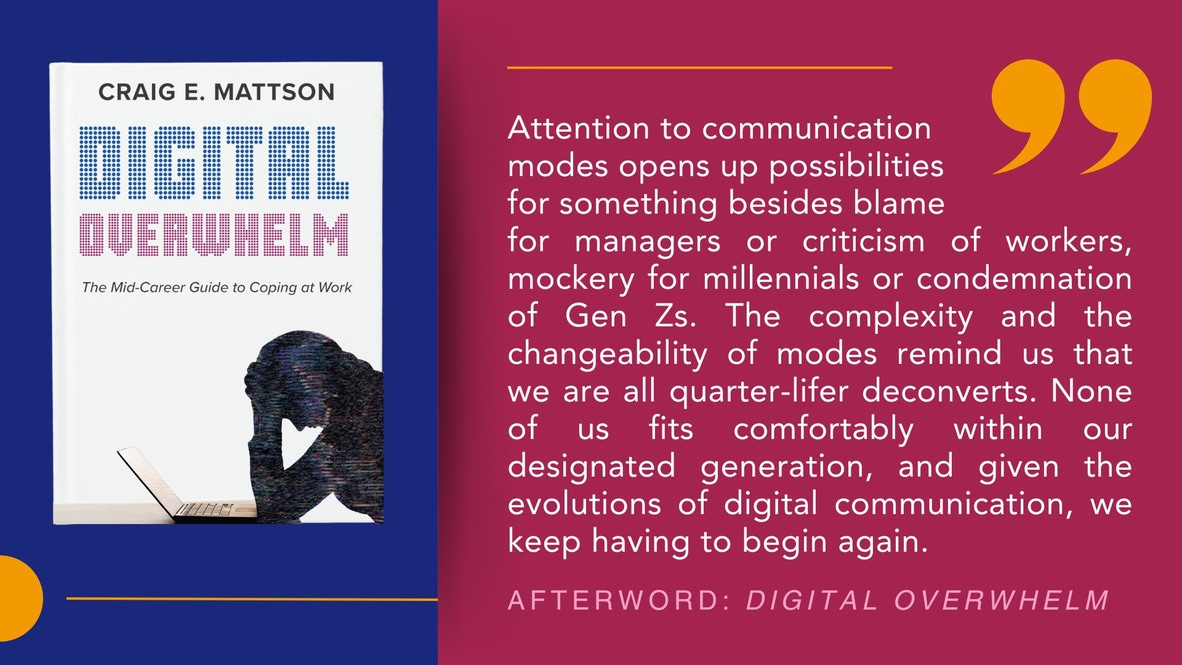How to big up your team's perspective
Fight small-picture thinking in your organization by using everyday communication to encourage contextual awareness.
Hey there, Mode/Switchers! Happy you’re joining this work-culture newsletter, a biweekly proposal for ways you and your coworkers can thrive in working community. On this newsletter’s off weeks, you’ll get a podcast from our intergenerational team, sorting out organizational approaches to human flourishing in the workplace.
But here’s this week’s question: how to use everyday communication to convert your team’s small-picture thinking into big-picture action. Let’s get to it!
The recent passing of the great American actor Gene Hackman has me thinking about The Conversation, which may be the greatest Hackman film you've never seen. (Reply to this email, if you’ve seen it and have thoughts and feelings!) The 1970s noir opens with a surveillance expert eavesdropping on a couple in San Francisco's busy Union Square. After scrubbing out all the crowd noise, Hackman's character hears this sentence: “He'd kill us if he got the chance." But then, he makes a critical error: assuming that because he’s eliminated background noise, he can automatically interpret the sentence. But although he has the words, he doesn’t have the context. The rest of the movie unspools the consequences of that mistake.
Your organization can make the same error when it gets stuck in small-picture thinking. For employees that might look like short-term thinking or disengagement (which costs companies trillions of dollars every year). For managers, “executive myopia” looks like micromanagement or a preoccupation with productivity to the exclusion of needed employee training.
If your organization’s people are prone to small-pic thinking, how do you help them take a larger view?
Let me recommend a shift in frame and a conversational intervention.
Another Way to Frame the Problem
What causes small-picture thinking in an organizational community? Often it’s fear—fear of complexity, fear of risk, fear of others. But sometimes it’s what ancient contemplative traditions would call acedia, a term for listlessness and distractedness. Especially in a world of digital overwhelm, it feels exhausting to change your frame and big up your story.
My colleague Jill Risner and I are working on a book about social media marketing for people who hate social media. Part of the reason people hate social media is that it creates echo chambers: the longer you’re on social media, the more you hear from people who look at the world just the way you do. Social media, in other words, seems to cultivate small-picture thinking.
But engagement with new media can do the opposite as well. Getting digitally overwhelmed can invite us to step back and reorient ourselves with questions like, “Wait, what is going on around here?” or “Geez, how do we stay human right now?” When we ask simple, big questions like that, digiwhelm can become an invitation to rehumanize our organizations.
We can also move towards big-picture thinking, especially as digital engagements almost require a foreground/background shift. New media compel you to think not just about goals and strategies (important as those are) but about algorithms and data and metrics. In this way, digital media invite attention to what John Durham Peters might call the “soft infrastructure” of your working community.
That reframes the problem, doesn’t it? Small-picture thinking isn’t just about being distracted. It is rather, as T. S. Eliot says in Burnt Norton, “being distracted from distraction by distraction.” Most people, I suspect, would read that line and say, “Put down your damn phone, people!” But our organizations need to us to re-engage our distracting conditions as a vital background picture. We can’t fix small-picture thinking simply by telling everybody to focus. Focus on—what? Instead, you have to give them a fresh feel for the fullness of your organizational situation.
And to do that, you’ll need the second half of this week’s mode/switch.
A Communication Intervention
My recommendation for doing big-picture work with small-picture teams is what relational frame theorists call tracking.
So, yeah, what is tracking?
Tracking happens when you pay attention to what’s working or not in your actual situation. For example, you track when you say something like, "When I do this, that happens." You also track when you concoct little rules for yourself: "Okay, next time that happens, I’ll do this.” You can see, again, why our digital context encourages this practice: even our wearable tech—Apple Watches, Garmin devices, etc.—aim to help you track what’s happening in order to figure out what’s working in life and work.
Tracking can be hard work, especially because it asks you to look at what you usually look through—like trying to spot a tiny crack on your windshield while you’re driving.
Let's say you’re convinced your team needs to do more market research to make sure your new product meets a felt need. You’re pretty sure the product is high-quality, but you’re worried nobody actually wants it. So you propose this research, and your team shrugs it off. Maybe they even get mad. They tell you they know the product is good. How do they know this? “Because we like it! And our clients are like us. And because we’ve made lots of products just like this one, and they sold great!”
Classic small-picture thinking. You need some scripts for big-picture intervention. Here are three to try.1
An imagination script: Imagine our company in five years--what do you think that future version of us would say about our current reluctance to do more research?
This question invites a change in perspective that allows for another "take" on the situation. It asks your people to get out of their stuck standpoint and to reexamine their situation. If that doesn’t work, you might try…
An opposition script: What IS NOT in our situation right now that makes further market research feel pointless to you?
You might have to read that script a couple of times to get the hang of it! But this thought experiment helps your team to look away from the foreground and look closely at the background. The goal is to help them big up their picture by tracking what's in the context and, more importantly, what’s not.
A concession script: Let’s say you’re right: we shouldn’t do any more market research. What big goal do you think we should be putting our efforts towards instead?
Note that this script creates a hypothetical (“Let’s say you’re right”) that creates a sense of collaboration and respect. But it also subtly focuses the conversation on big-picture aims. Ultimately, this line of conversation helps your team track the connections between actions and goals.
A final thought
At the end of the The Conversation, Gene Hackman’s character has sunk to the level of his obsessions, having become utterly convinced that someone is bugging his apartment. The surveillor, he thinks, has become the surveilled. So he tears his living space down, board by board, searching feverishly for the suspected listening device. He never finds it. The movie concludes with him sitting on the studs of his deconstructed house, playing a saxophone. He is the embodiment of a lonely small-picture person who has discovered, too late, how to find harmony where he dwells.
In organizational life, grasping the big picture can’t be a solo project. Self-help newsletters like this one often focus on changes you need to make to you. But I’m writing this week to encourage you to use everyday communication to encourage change in the people around you. You want to speak in such a way that they start to track the situation for themselves. It won’t help their small-picture thinking if they simply adopt your big-picture thinking. They’ve got to own it for themselves. And you’ll benefit from their wisdom when they do!
-craig
Looking for more ways to big up your team’s gaze in digital spaces?
Readers of third-wave behavioral psychology may recognize that I’m adapting these scripts from recommendations in Mastering the Clinical Conversation, a book for therapists who are trying to help their clients think more flexibly. But there’s a sense in which we are all having to be each other’s therapists these days, especially at work.





